The ways that we eat and cook have changed during the COVID-19 pandemic. There have certainly been struggles but also some surprisingly positive improvements. Let’s reflect on two questions: “How did you eat?” and “How will you eat?” I’ll share my experiences—plus valuable tips on coping with kitchen burnout.
The Early Days: Stocking Up
Many grocery stores had to adjust to different shopping patterns. I live in rural New Hampshire,* so it’s essential to prepare for a long stretch during any type of emergency. We prepared for COVID-19 quarantine by stocking up on a few months’ worth of basic staple foods, a 200-gallon water-storage bladder in case we lost power (and our water pump), and a sizable stash of first-aid supplies.
My gardening plans changed, too. Although I’d hoped to cut back on the size of our vegetable garden this year, we planned and planted an even larger one, concerned about the food-supply chains in New England this winter. Fortunately, I ordered seeds and supplies early, as I always do.
Many veteran gardeners with the same idea joined with hopeful first-timers, and seed companies quickly ran out of vegetable seeds last spring, when they couldn’t fulfill all the needs of their longtime commercial growers. Now that most seed companies have replenished their stocks, I’ve ordered many of our favorite seeds for our 2021 garden. Trying to stay ahead of the curve!
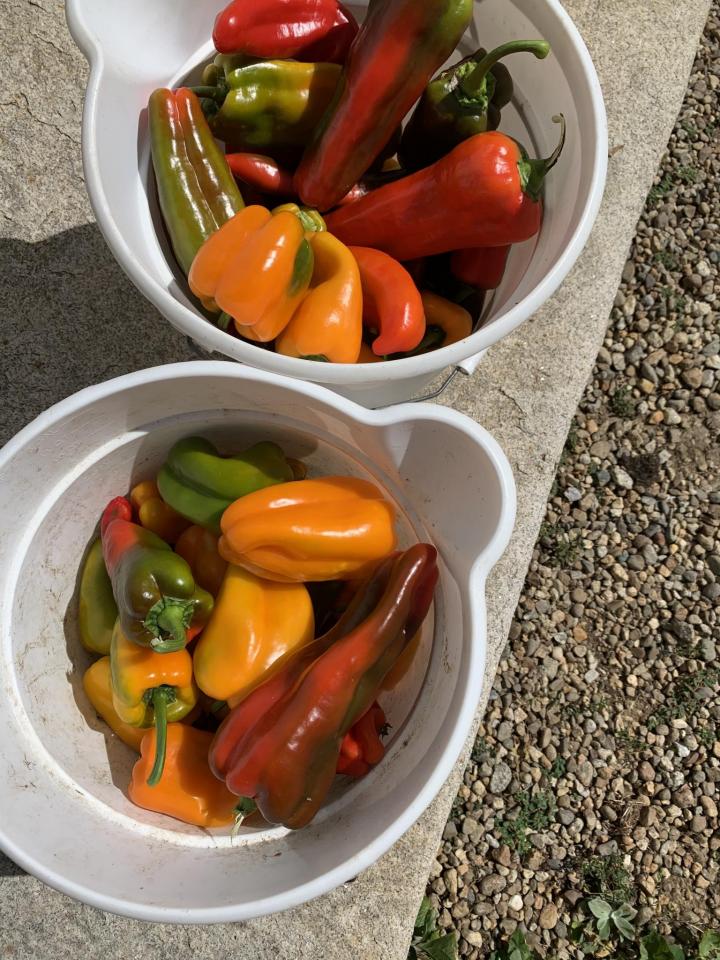
I grew 65 pepper plants. I roast them till the skins are blackened, then remove the skins in the seeds and freeze them for winter chilis/soups/salads.
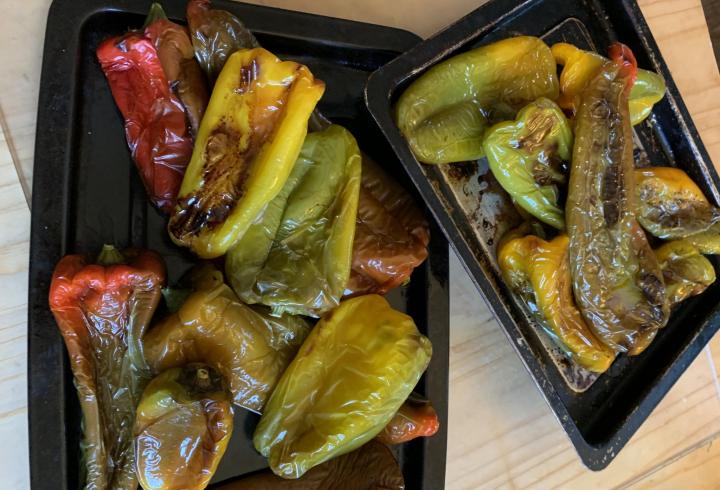
How Food Shopping Changed
Grocery store shopping and restaurant eating underwent a rapid and astonishing transformation with shortages and clossings. Some longtime observers of the nation’s food and farming conditions predict that these will result in permanent changes to the fabric of American agriculture.
Here’s a timeline from my vantage point in central New Hampshire. Does it compare with what’s transpired in your area?
- Soon after the pandemic was declared and most areas went into lockdown, food sellers suffered a period of chaos, marked by extreme shortages of toilet paper, flour, yeast, and household disinfectant products (mostly due to hoarding). Many areas had shortages of meat, poultry, and dairy products, too.
- Food stores began allowing only a handful of people inside at one time. This created long waiting lines and widespread anxiety, especially in areas where weather was a factor.
- Within a few weeks, most grocery and specialty-food stores had posted one-way arrows to keep shoppers moving through the aisles in one direction, thus avoiding face-to-face encounters.
- Some stores began offering curbside pickups, allowing customers to place and pay for their orders online, then drive in, announce their presence, and open the trunk for a contact-free pickup.
- Delivery services started exploding in popularity, offering personal shoppers to collect and deliver groceries from local stores to our doors. Customers ordered, paid, and tipped online.
- Small businesses starting getting creative. An agricultural-products store up the road from us started selling fresh fish from a New Hampshire–Maine fishermen’s cooperative to help the fisher-folk survive when restaurants and schools locked down. It was pricey, but the fish were fantastic. We’d call in our orders by Thursday morning and pay online; they’d drive to the coast to get the fish on Friday morning, and we’d pick up our fish in the afternoon.
Early on, when shortages became severe, I went online and secured a 2-pound bag of baker’s yeast, a 50-lb. bag of whole wheat flour (repackaged into 5e-pound bags tucked into the freezer), 20 pounds of pizza flour from a family farm in Montana, a giant bag of green lentils, several vacuum-packed bags of dried fruit and nuts, and a stash of our favorite Vermont cheese. (Aside: With most offices, schools, and restaurants locked down, our local office-supply outlet gladly delivered large boxes of office-style toilet paper and 3-fold paper towels that saw us through the early months.)
Some Good News
- The shortages in the food chain meant more Americans turned to local sources for food, boosting some small businesses.
- Farmers’ markets and community-supported agriculture programs (CSAs) started advertising online ordering/payment and contactless pickups at the most easily accessible local farm. Fruit and vegetable sales skyrocketed.
- Meal-kit businesses soared in popularity, including those with kits of precooked, ready-to eat-dinners.
- Somewhat inexplicably, tofu sales also skyrocketed.
- Companies such as Imperfect Foods and Misfits Market, which deliver boxes of fruit and vegetables that are oddly shaped, too big, too small, or off-color, also experienced an explosion of new customers.
- Meal deliveries from local restaurants also soared in popularity, but threaten the restaurant industry itself now and in the post-pandemic future.
Disinfecting and Sanitizing in the Home
Many of us starting washing produce more than usual. Even though experts told us that there wasn’t much chance of picking up the virus from food or food-packaging materials, we disinfected our produce and we still do. The routine gives me a small measure of comfort and security.
- We place all nonperishable items in a two-day quarantine on the porch before storing or using them. Then we wash our hands.
- We lather and rinse all perishable-food packages or containers with soap and warm water before refrigerating or freezing the food.
Read more about COVID-19: Disinfecting Your Home: What Is Disinfecting Versus Sanitizing?
More Cooking at Home!
The good news is more people are cooking at home—and simply eating together. Kids and parents are spending more time at the dinner table.
Almost overnight, many people started working from home, often quarantined with their spouses and learning-at-home children. Read more about COVID-19: Social Distancing, Quarantining, Isolation—What Do These Terms Mean?
Among the 85% of folks who have made some sort of pandemic-related change, the biggest area that has been subject to change—by far—is cooking at home, which 60% of Americans now report doing, according to a national survey.
People who’d never cooked before began learning to, often stunned to discover how challenging it could be. I chuckled over hundreds of online photos of home-baked sourdough breads—the occasional lovely loaf, but mostly dismal failures—and of novice-cook dads beaming over their relative success with grilled cheese sandwiches, pizzas-on-English muffins, and canned-bean/hot dog masterpieces.
Americans are eating healthier (mostly)
- Thanks to more cooking at home, approximately 22% of Americans are eating healthier than they usually do, yet about 14% say that they’re eating less healthfully than before. For those who had never cooked, this was was probably all about a learning curve.
-
More people began making more positive food choices overall: 43% of respondents reported eating more fruit now than before, 42% reported eating more vegetables, and 30% are eating more protein. Eating more plants is certainly a healthy trend.
-
Baking has also become more popular. Both sourdough bread and the easier banana bread rising to the top of Google recipe searches. Baking has many wonderful benefits from stress relief to mindfulness. Plus, we often bake for each other which allows for that human connection.
-
However, snacking has increased, perhaps not surprisingly! About one-third of Americans are snacking more often than they did before the COVID-19 crisis, and 10% are snacking less. Salty and savory snacks reign, but cookies have also been popular.
Here in our household in rural New Hampshire, daily life proceeded much as it always has. By early April, we were getting frantic with dawn-to-dusk garden work: planting, mulching, and irrigating, to be followed later by harvesting, freezing, canning, and root-cellaring.

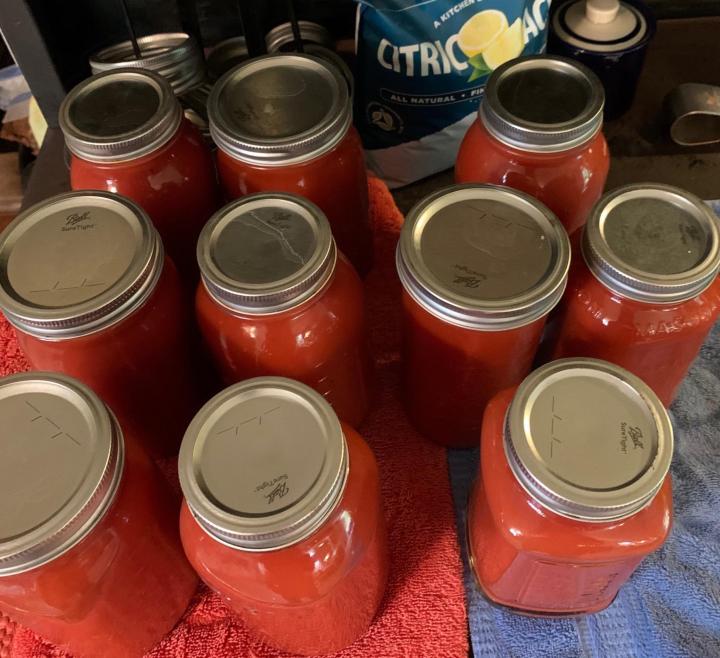
Although our region suffered from a debilitating drought all season long, our little backyard pond supplied enough irrigation to enable a harvest of bumper crops of various berries, salad and cooking greens, beans, tomatoes, peppers, beets, watermelons, and cantaloupes.
This bounty enabled us to trade excess vegetables and fruit for fresh eggs, peaches and apples (we don’t grow tree fruit), and winter squash (our crop got decimated by drought and insects). I traded half a bushel of peppers with my farmer neighbor for about the same amount of peaches. The fruit wasn’t perfect but after cutting out the bad spots, I got a dozen pints of raw chunks to freeze & enough pulp to make a double batch of jam.
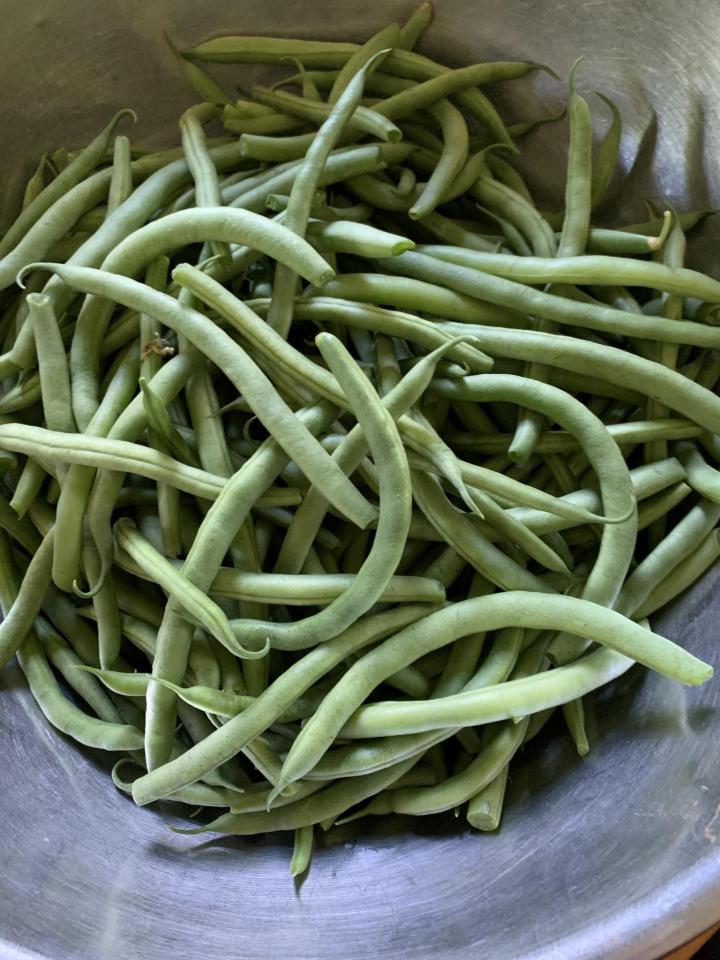
Image: Green beans ready for frenching!
As always, we didn’t have much time to experiment with new recipes, relying on tried-and-true summer meals: Some protein food paired with a gigantic salad or a platter of sautéed/steamed/roasted vegetables.
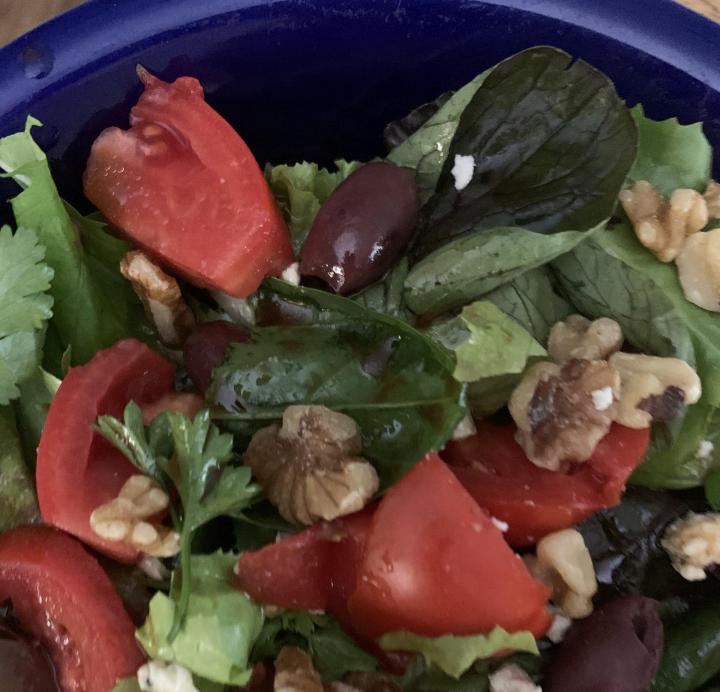
One stellar exception: my discovery of oven-baked German pancakes, smothered with our local maple syrup. I kept thinking about it, but I never did get around to trying the grilled watermelon steaks that fancy cooks were writing about. We had gorgeous watermelons, utterly delicious and quickly cut and served for breakfast, lunch, dinner, or snacks—except for the few that we traded.

Kitchen Burnout and Pandemic Fatigue
I’ve always loved to cook, but the thought of planning and preparing food (especially dinners) has gradually become onerous. Every single aspect of growing, shopping for, and preparing food seems exhausting. Altogether, they seem to consume most of my waking hours.
I’ve since learned from friends and social media that I’m not alone. Even professional cooks and food writers have been suffering from pandemic-caused kitchen burnout. When there is freedom of choice and perhaps lack of vareity, cooking can be less rewarding.
Here are some steps to deal with burnout:
- Solicit a lot more kitchen help. Cooking with another person can be more meaningful (thought not always so know yourself!).
- Toast a lot of open-face cheese sandwiches. Slap crunchy peanut butter on toast. Serve with fruit, sliced tomatoes, leftover steamed vegetables, etc.
- Instead of a regular salad for lunch, pile on toppings to add interest and taste: sliced avocado, roasted peppers, olives, jarred artichoke hearts, capers, pickles, you name it!
- Put some vats of the ever-versatile beans and lentils on to simmer until soft, cool them down, and freeze them. If inspiration doesn’t strike, defrost a container, spice it up, and serve hot (topped with melted cheese), cold (commingled with salad ingredients), or stuffed into a taco, tortilla, or flatbread roll-up.
- Cook less often but for longer sessions: Make three- or even four- or five-meal specials: black- or white-bean chili, giant pots of soup, sheet meals (a variety of roasted vegetables with pieces of chicken), quiches with or without crusts. After the second day, freeze leftovers for later.
- Experiment. It may sound counterinuitive but try a challenging cooking activity so you learn something new and have a sense of accomplishment. For example, try baking bread! It’s very comforting as well as delicious and nutritious.
- Forget about “traditional” meals. Who cares if we eat breakfast foods for lunch or dinner? Who cares if dinner leftovers appear on our breakfast plates?
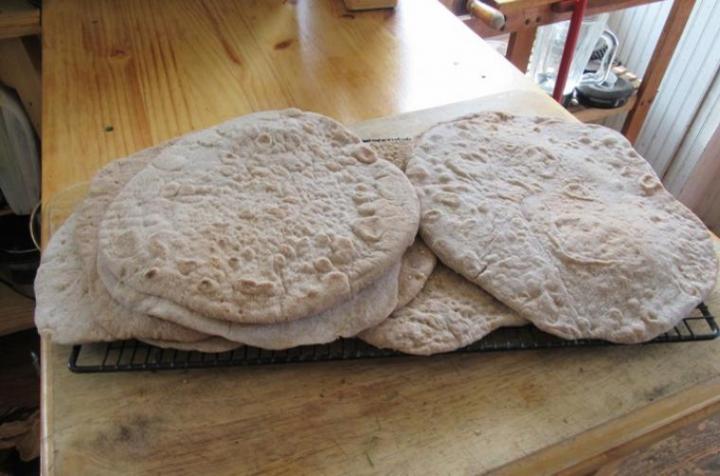
See how to make easy flatbread!
So, answering the top-of-the-list questions I opened with:
“How did we eat?”
We ate adventurously, as well as we could manage.
“How will we eat?”
It’s anybody’s guess, but adventurously, for sure!
Tell me: How did your food shopping, cooking, and eating change during this unusual time? Did you pick up any new habits, good or bad?

















